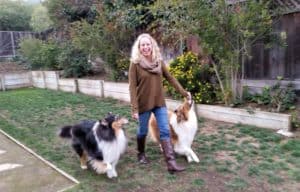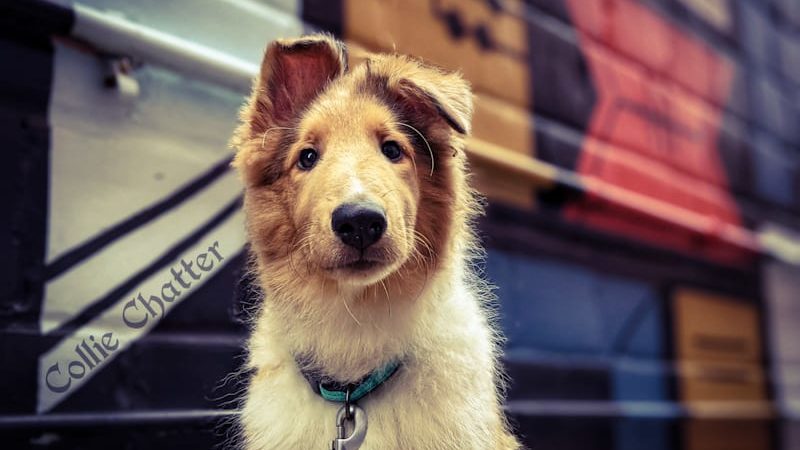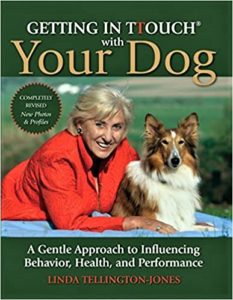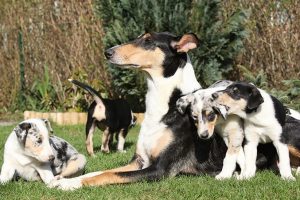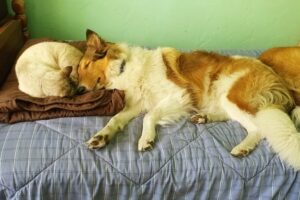As a former special needs teacher, I worked with students who had ASD (Autism Spectrum Disorder). I have often wondered about the possible occurrence of autism or other special needs in dogs. The equivalent of autism in canines is labeled Canine Dysfunctional Behavior (CDB).
According to The Veterinary Nurse, a peer-reviewed, UK-based journal, “Dogs have not evolved with the innate skills to relax in the complex human environment and consequently frequently fail to cope. Physical or emotional distress experienced during puppyhood can have permanent effects on emotional and behavioural developments…” The article also points out other factors that affect puppy development, such as in-womb conditions and genetic influences.
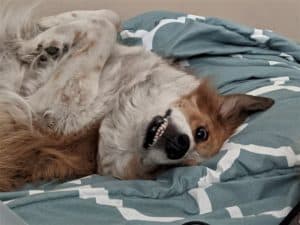
Can dogs have developmental delays? In essence, yes, dogs can have varying types of developmental delays which are dependent on multiple factors. However, there is not much available online in discussion of what such delays could look like, and the little that is available is not necessarily written to be clear and accessible for the average pet owner. So I was delighted to read what certified animal behaviorist Julie Bond (formerly on staff at the San Diego Zoo) wrote about her experience with a dog who has a developmental delay, and I was even more delighted when she agreed to let me repost it on Collie Chatter!
I know I learned much from reading about Julie’s client and their dog, and I’m sure you will, too.
– Emily Sowulewski

Developmental Delays in Dogs
I met with a client this week who has been struggling with her dog for a couple of months. His body is big and he’s passed his first birthday, but he still behaves like a puppy. He has accidents in the house; he chews anything and everything (no piece of furniture is safe); he doesn’t heed signals from her other dogs when they shun his exuberant behavior; he’s very needy; and he still needs enforced nap times. Basically, he’s a 120 lb (54 kg) puppy, and his owner is quite frustrated and downright concerned. Her veterinarian told her that she doesn’t discipline the dog enough; her neighbor told her the dog needed more training; and her family has told her that the dog isn’t welcome at family events until she can get better control of him.
When I observed this dog, here’s what I saw immediately: a puppy. Not an adolescent dog. Not an adult dog, but a puppy. A BIG puppy, but a puppy nonetheless. His behavior was consistent with what you would expect to see in a 6-8 month old puppy, not a dog who had just celebrated his first birthday. He wasn’t being defiant when he pulled on the leash, he was excited to explore! He wasn’t being defiant when he chewed on the furniture, he still needs direction to appropriate chewing outlets and boundaries to help him make the right choices. The hardest thing will be helping this big puppy move past his fears and uncertainty when out in public so that it’s safe for his owner to walk him. (When he gets scared or spooked, he wants to bolt for home).
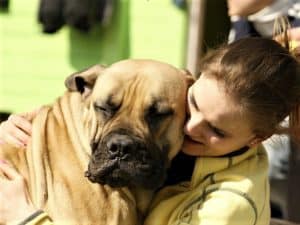
Dogs, just like people, can experience developmental delays. Those delays can be genetic in origin, or they can be due to something that happened during the dam’s pregnancy, during birth, etc. Some puppies get stepped on or laid on, and some are born as singletons or the runt of their litter. All of these scenarios could result in a puppy, and thus a dog, with developmental delays.
If your dog has developmental delays, you will need to be more patient with her. She may take longer to get through puppyhood, experiencing longer or more frequent fear stages, having accidents in the house more often, and seemingly ending up over threshold or being more reactive than other puppies or dogs her age. Thus, while most people report their puppies, regardless of breed, being completely housetrained by the time they are 10-11 months old, a puppy with developmental delays may be 18 months old before reaching that milestone. And while most puppies go through four fear stages in their first year, a pup with developmental delays may seem to be stuck in a fear stage for weeks to months at a time. It is also true that while most gangly, loose-limbed puppies become sleek, well-coordinated adolescent dogs, those with developmental delays may seem off balance or uncoordinated a bit longer. One caveat to all of this, however, is you can’t just assume an adolescent dog who is still having house training accidents – or is fearful, or seems to trip over her own feet – has developmental delays. Your first step always is to visit your veterinarian and rule out the other, medical causes for these behaviors before assuming that a developmental delay is the culprit.

So, back to my client. She’s been to see her veterinarian several times to rule out medical issues because she was sure her dog must have had a bladder infection given the number of accidents the dog was having! Nope, the dog is perfectly healthy, just really a 6 or 7 month old puppy living inside the body of a 1 year old, young adult dog.
Action plan to ease my client’s anxiety and help her dog thrive/ mature to the best of his abilities:
1. Set and maintain clear boundaries
While my client had crate trained her dog as a puppy, she’d quit using it once she thought he was an adult and wouldn’t need it anymore. We are bringing back the crate for nap times, and enforcing those nap times, to make sure this dog is well-rested. We are also introducing an x-pen to confine the dog when he’s awake but can’t be supervised. That way, he can’t chew the furniture or constantly pounce on her senior dogs for attention.

2. Adhere to a predictable schedule
Having a set schedule that the dog can predict and that the owner can stick to will be key. A lot of anxiety for dogs comes from not knowing what will happen next, or thinking it’s time for something to happen – and then it doesn’t. For dogs with developmental delays, willy-nilly schedules and missed walks for example are not just frustrating, they are anxiety-provoking and stressful.
3. Increase both the mental and physical exercise the dog receives daily
Two walks a day with a focus on sniffing and exploring are a must. Simple, interactive toys like snuffle mats and food-dispensing balls to build brain connections are also necessary. The third component we are adding in is balance and coordination boosters, which will ultimately increase the dog’s confidence. Using wobble boards, hula hoops, and bosu balls, this dog will learn to balance his big body and lift himself a few inches off of the ground, thus enabling him to step off a curb without tripping over his big feet.
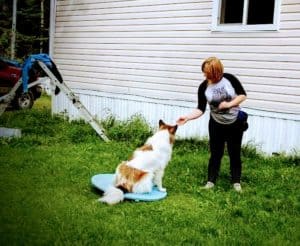
4. Increase the amount of time the dog is on leash
We are going to keep my client’s dog on leash more; he can drag it around the house so that someone can step on it, if need be, to keep him from jumping up. He can also be walked on leash inside the house to increase his confidence with being on leash and help him to learn not to pull. There is no hard and fast rule that says walks on leash need to be outdoors. Leash walks can be done anywhere, inside the house, in your yard, in your garage, etc. Anywhere you have space to walk with your dog is an opportunity to work on leash etiquette.
5. Clear communication
Using hand signals and verbal markers, my client will make a bigger effort to connect with her dog. He watches her all the time, waiting for feedback, and now she’s going to make a conscientious effort to give it to him. She will let him know when he’s having success by saying “Yes!” and doling out treats, and she will use redirection and time outs for when he invariably makes mistakes. She’s going to learn t-touch so she can use handling and massage as a way to calm her dog and reinforce their bond.
We all learn differently and at different paces. Some people find math easy, for example, and others think of math as a foreign language they just can’t figure out. Dogs are just like us in that regard. Some find learning to walk on a leash to be very easy, while others find it quite challenging and anxiety-provoking. There’s one thing we can all agree on: the world of dogs and dog owners has plenty of room for all types of abilities and aptitudes.
The original version of this post appeared on Julie Bond’s blog The Animal Behaviorist Is In.
Edit: another handy tool to increase a dog’s strength and coordination is a balance disc!
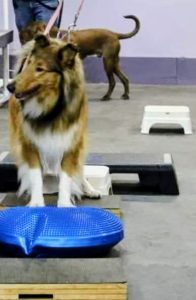
Julie Bond is a certified animal behaviorist, treating pet behavior problems in the San Francisco Bay Area of California through her business, P.E.T.S. She is also a writer, blogger, speaker, and keen observer of all things Collie. Read more of her posts here, follow her on Instagram @k9freud, or connect with her on Facebook @JulieBondPetEducationTrainingServices.
